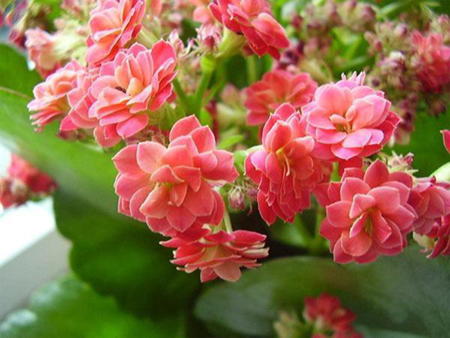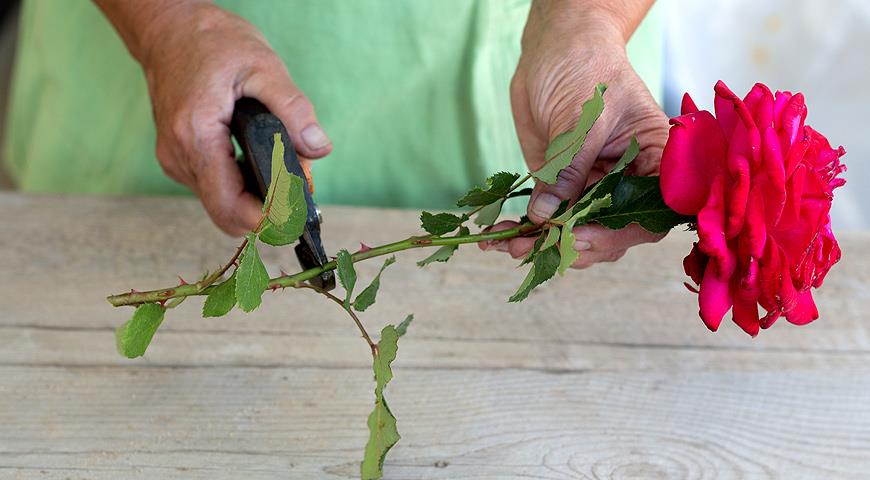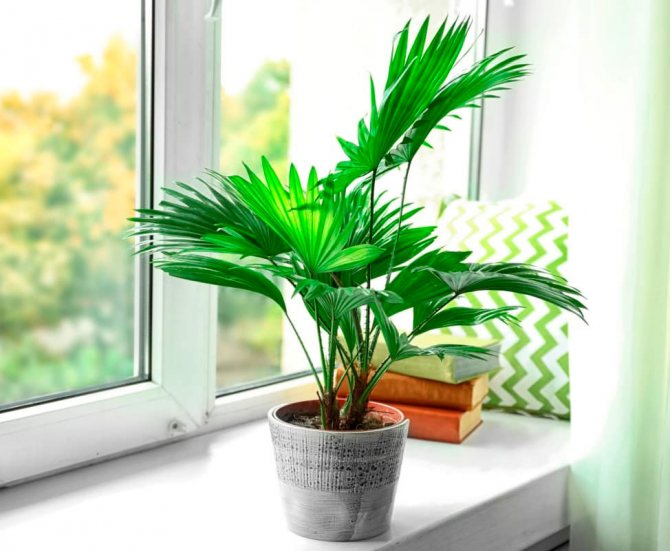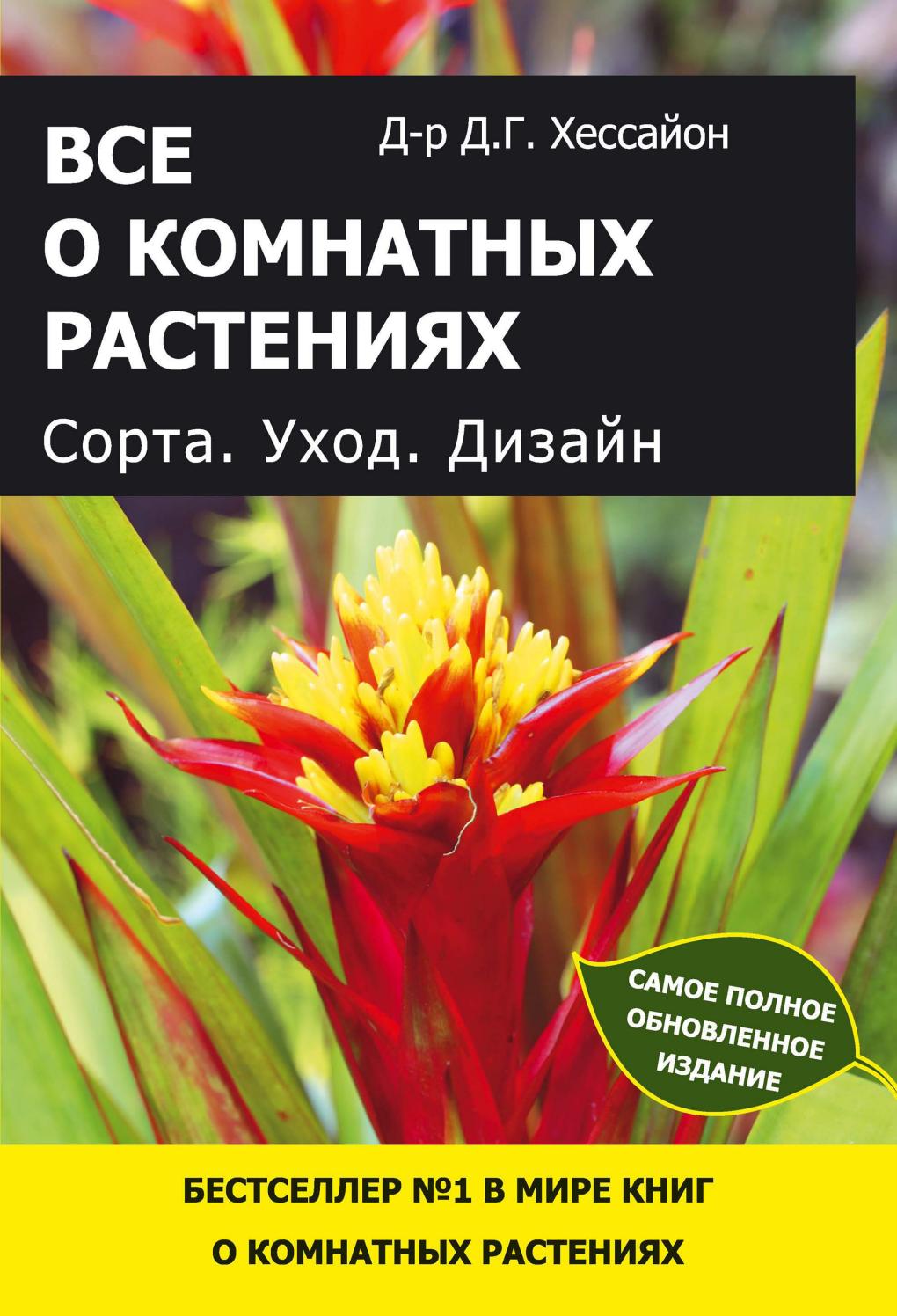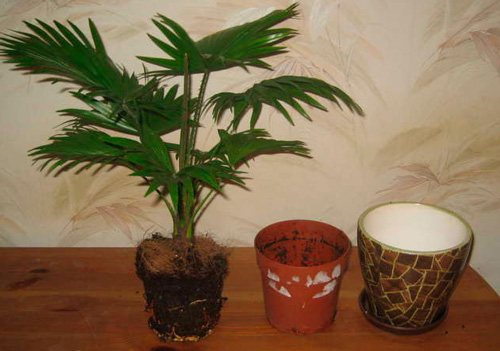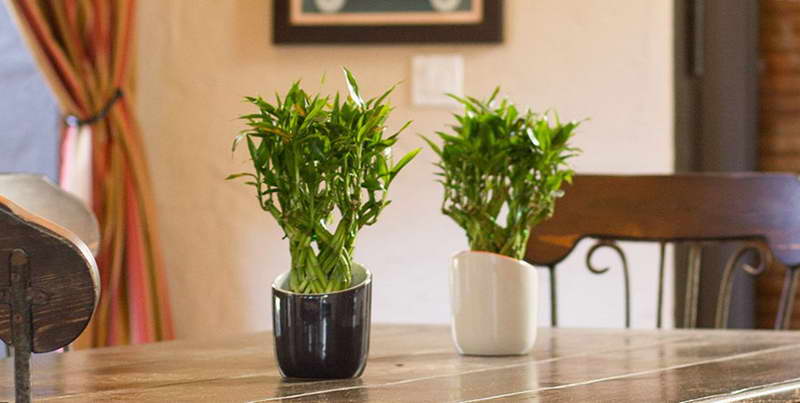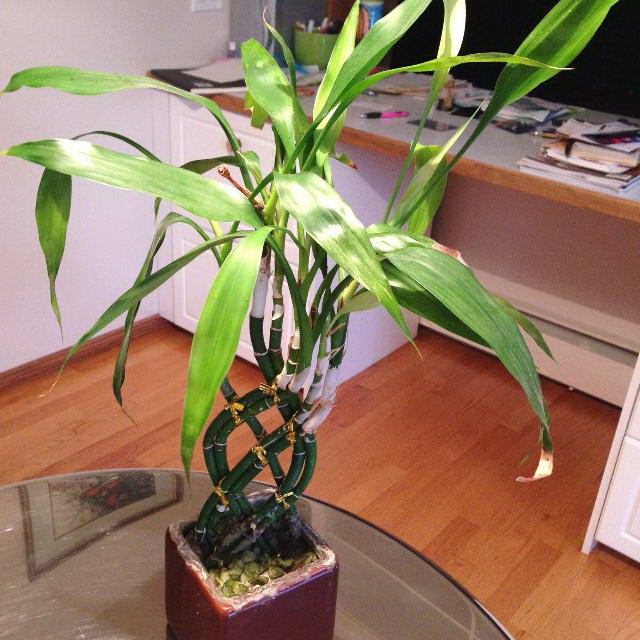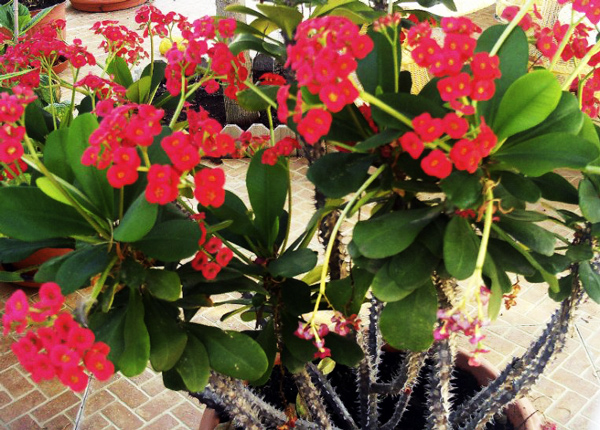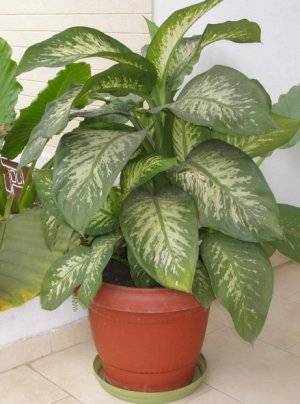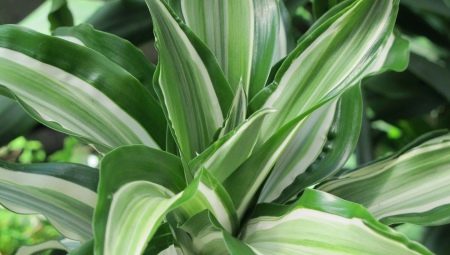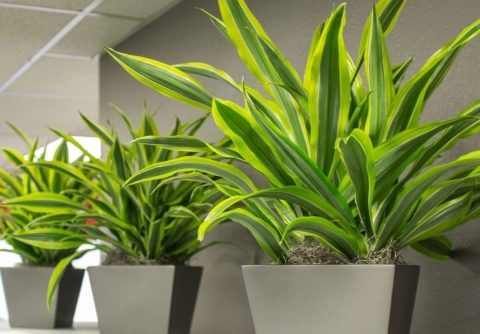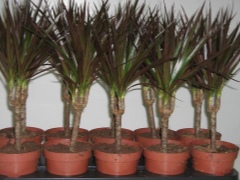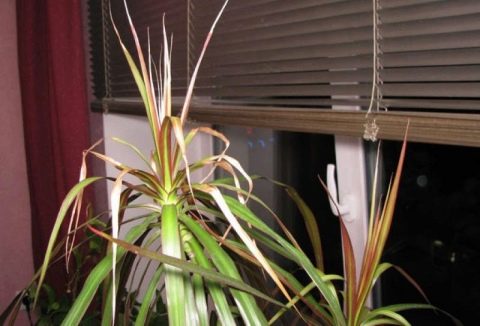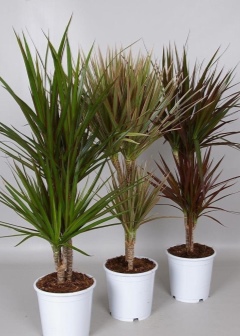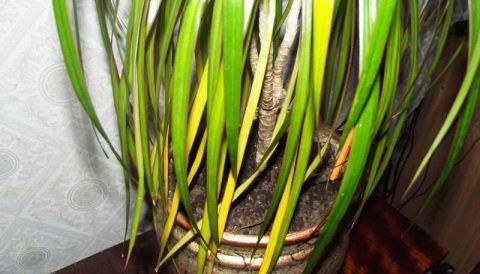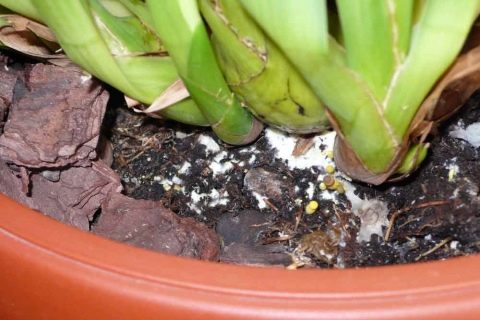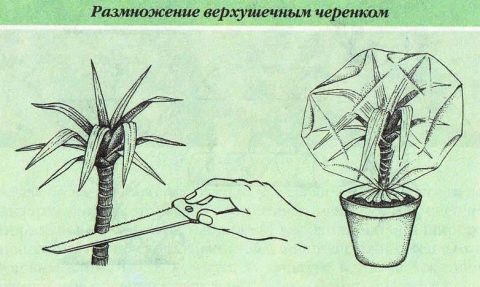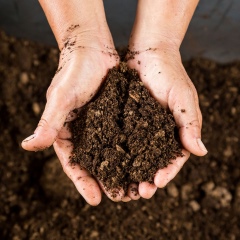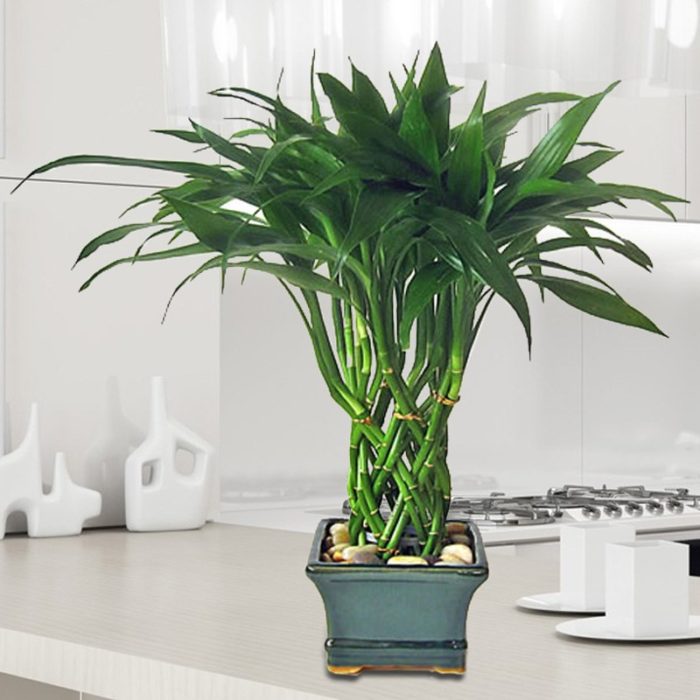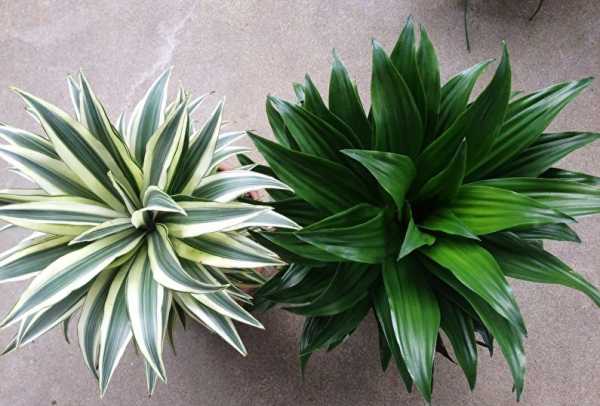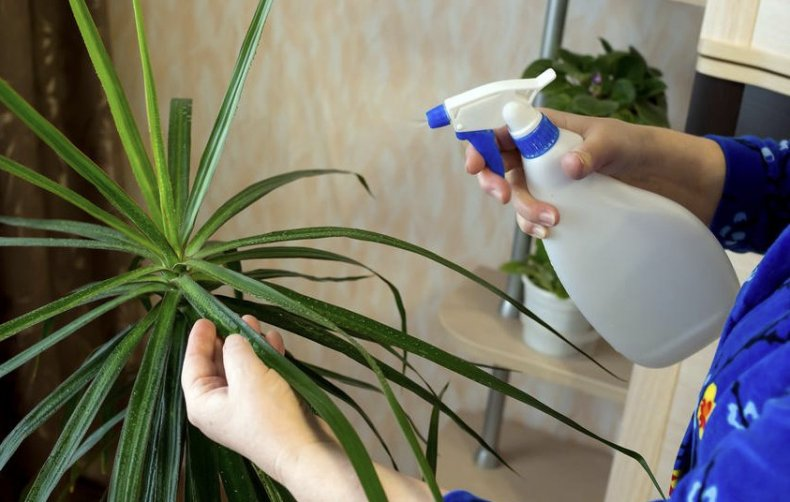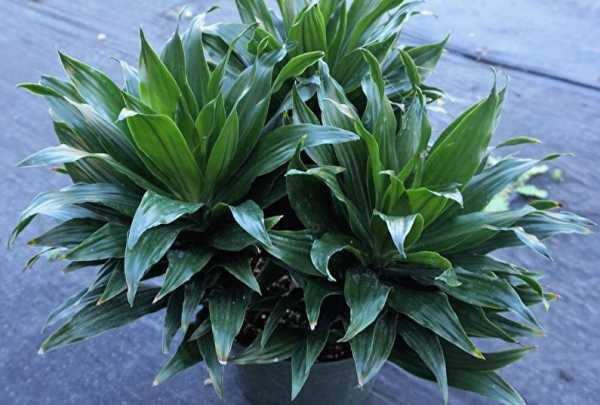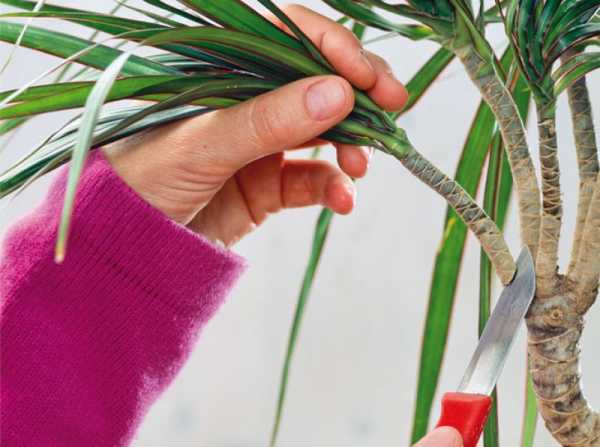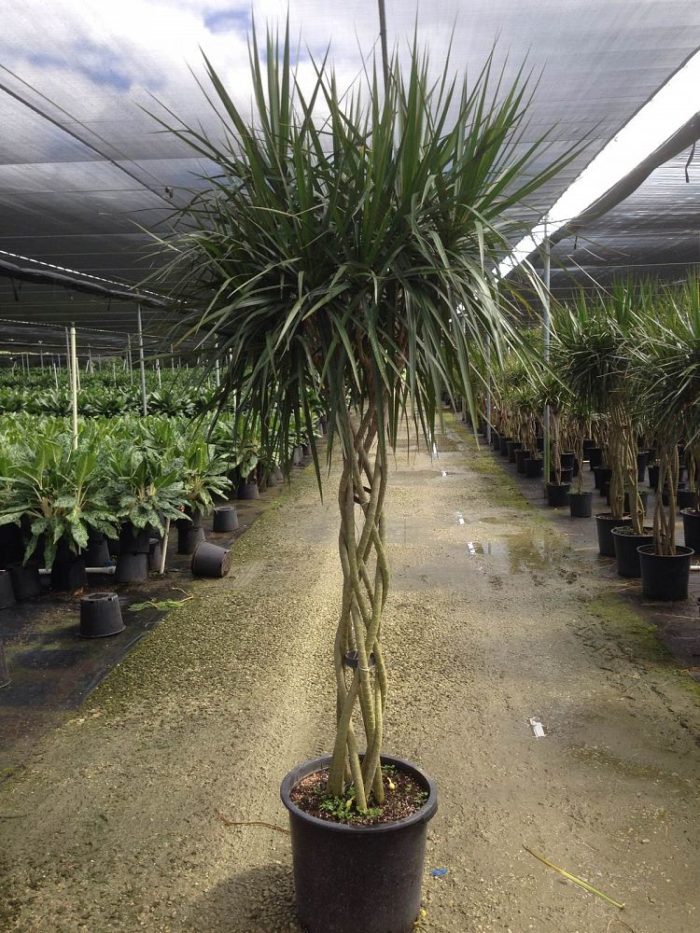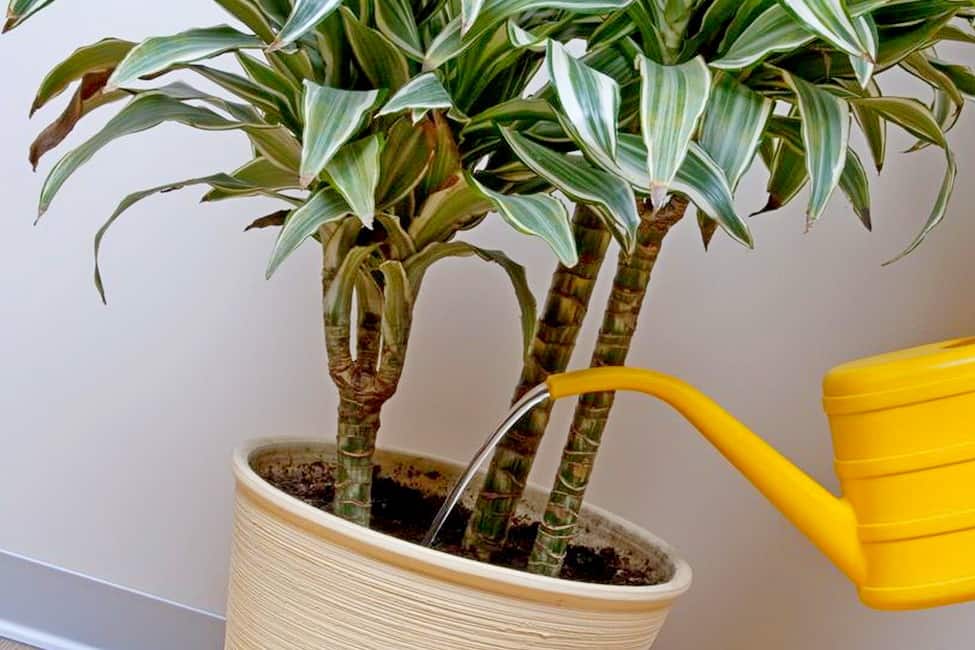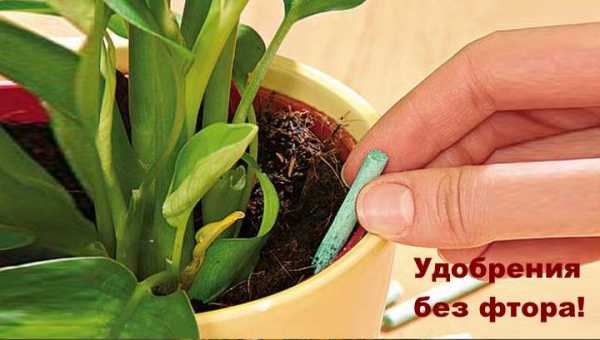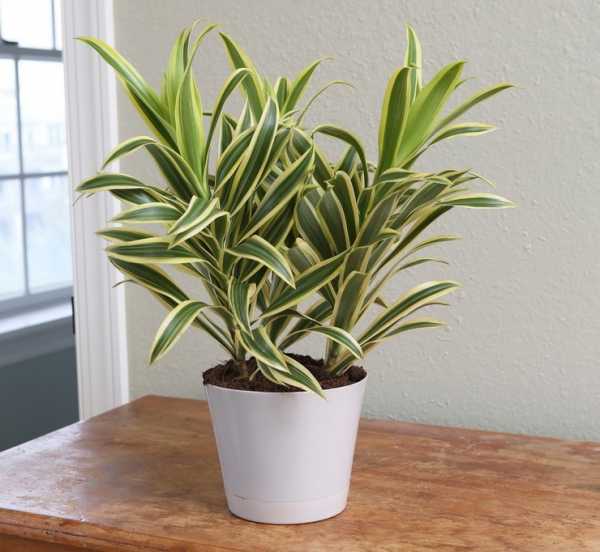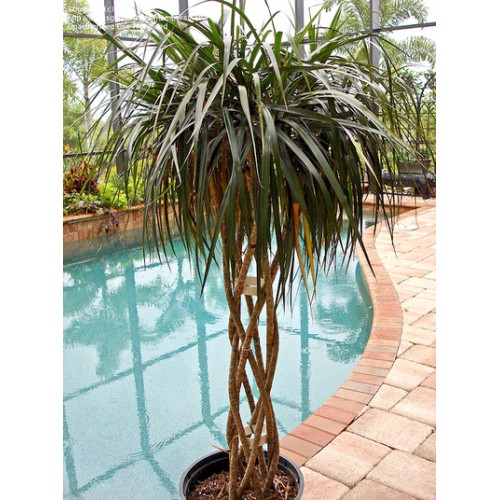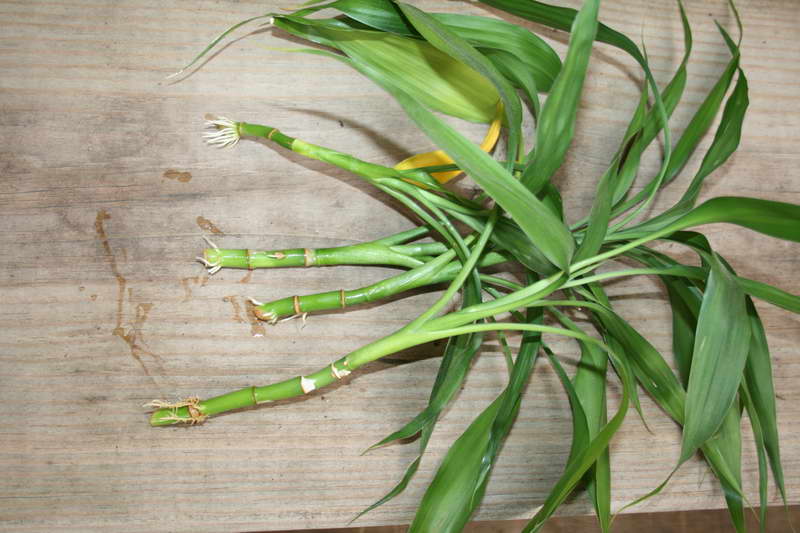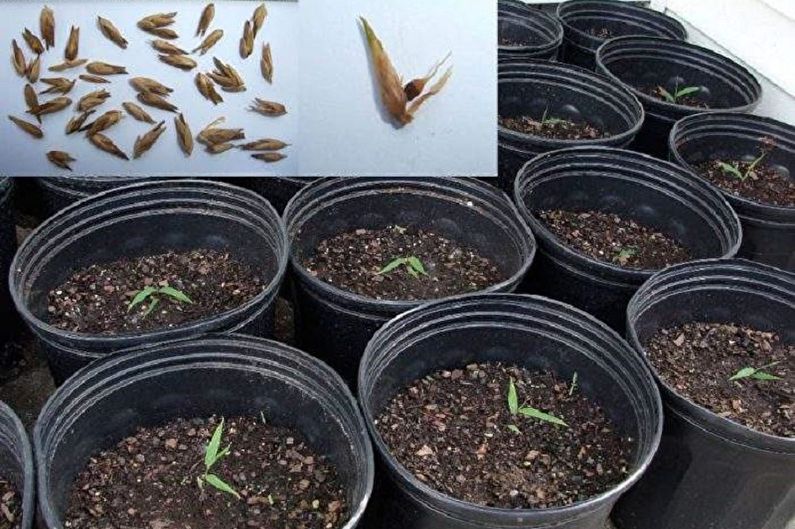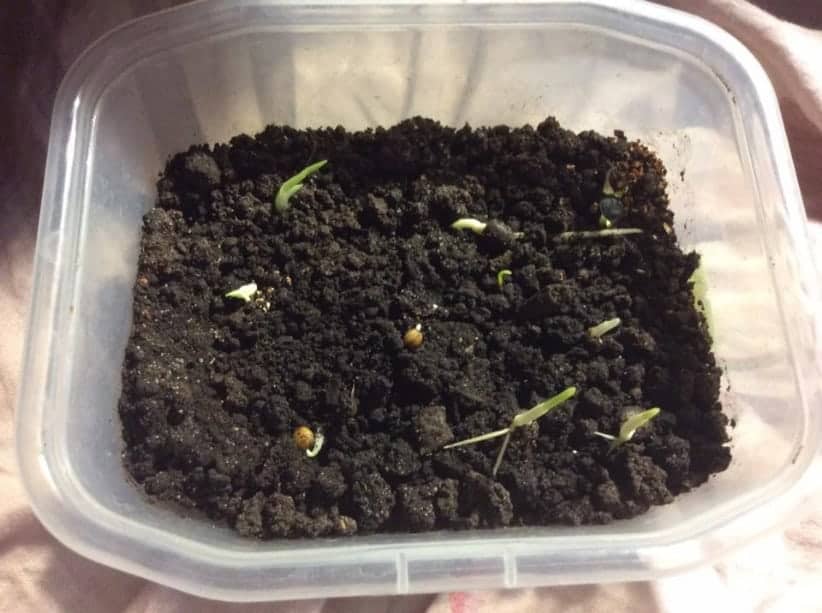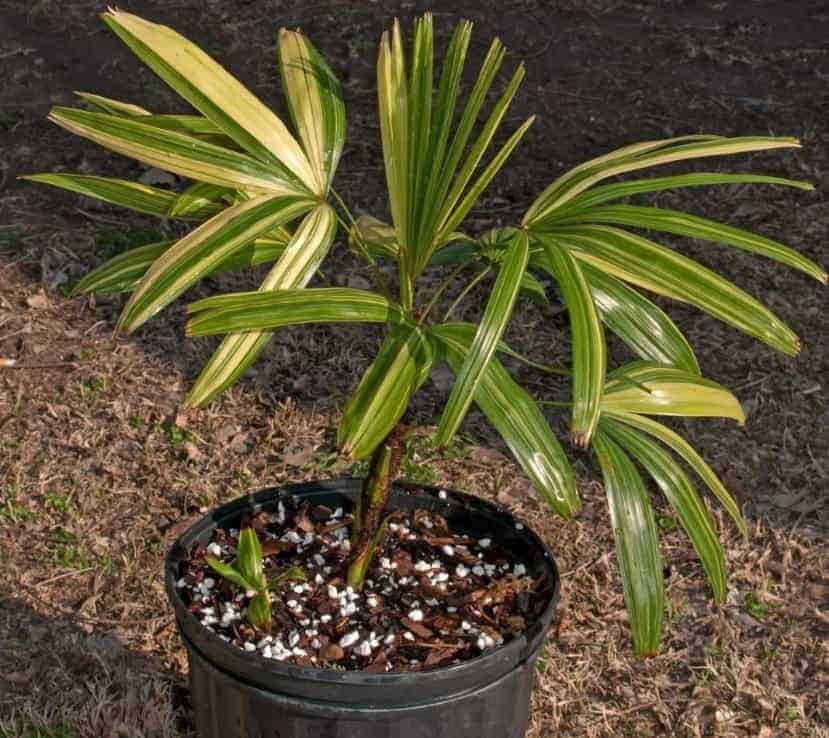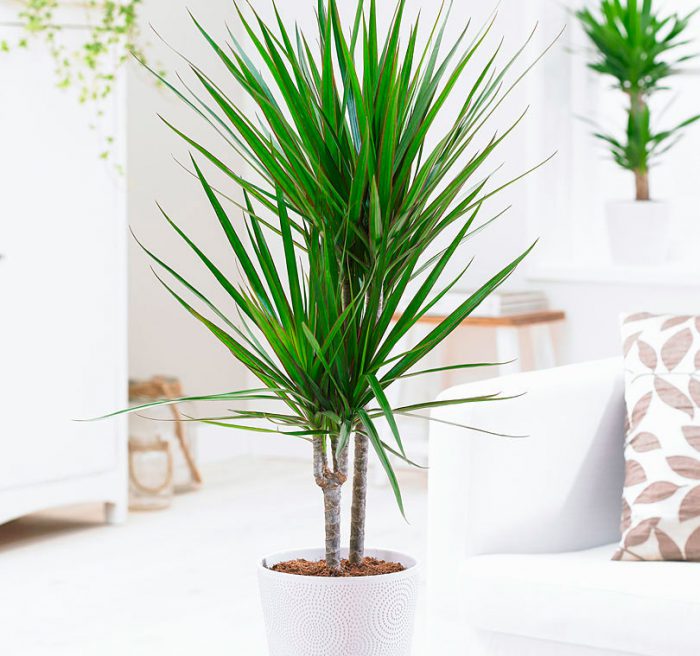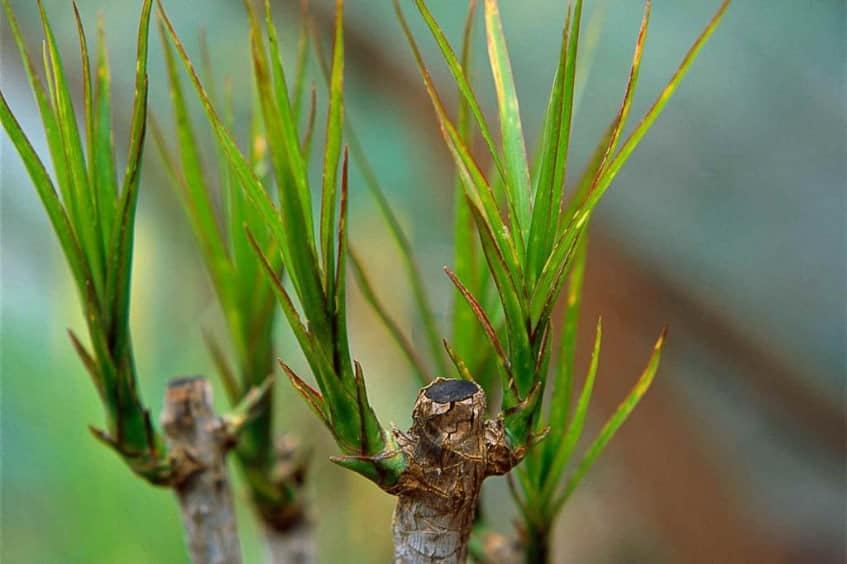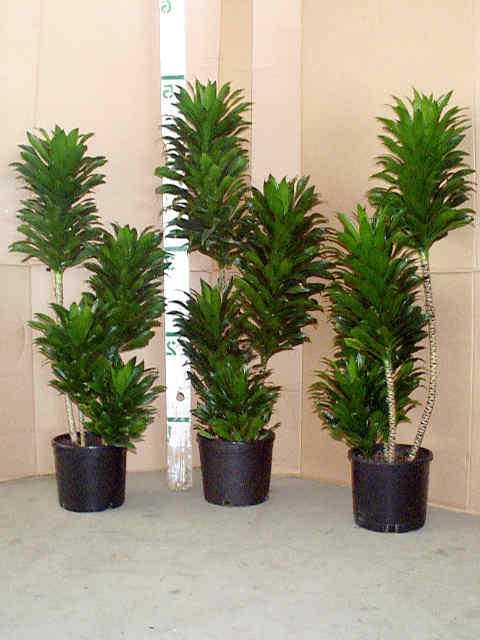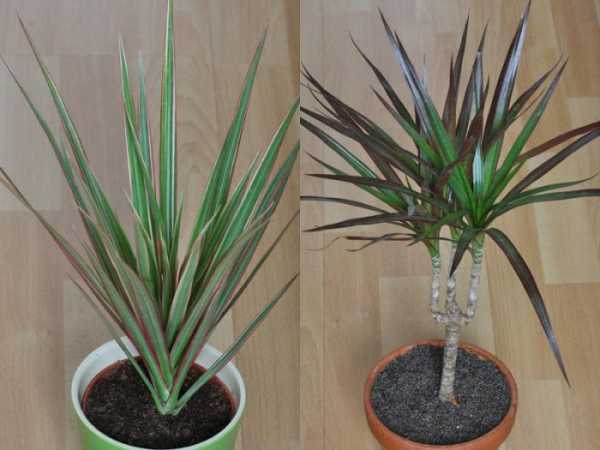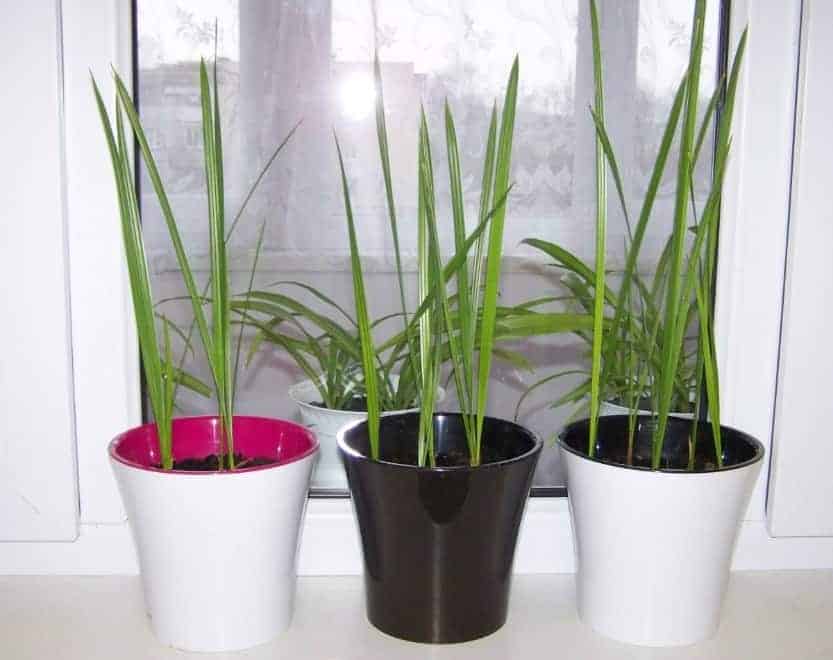Propagation of dracaena by apical cuttings
If there is an adult dracaena in the house that has lost its former attractiveness, it's time to update it and grow a young specimen with its help.
The top of the shoot covered with leaves, together with part of the stem, is cut off with a sharp knife. It is optimal if a clean cut perpendicular to the trunk is at a distance of 15–18 cm from the last leaf. All leaves and old foliage are removed from the stem. After that, the future dracaena seedling is dried for 2-3 hours in room conditions.
You can root a stalk taken for reproduction of dracaena at home:
- in ordinary water with a small addition of a root stimulant and charcoal;
- in a mixture of crushed coal, sand and peat;
- in vermiculite or perlite at the choice of the grower;
- in steamed soil for dracaena or decorative palm species.
Cuttings should be rooted in a greenhouse or under a film cover, the humidity inside which can be regulated by ventilation. To do this, the shelter is opened twice a day for 15–20 minutes.
To prevent root rudiments from decaying or drying out, you need regular, but very careful watering and maintaining the temperature within the range of 20-22 ° C. Seedlings are good for spraying. Only the water is better to take warm and always settled. In the same way, with the help of a spray bottle, plants can receive the first feeding in their life.
A video on how to propagate dracaena at home will help you to study the process in detail and get answers to your questions.
The stem with the root system remaining after cutting should not be thrown away! If you cover the upper cut with a bag, and put the plant in a pot in a warm place and water it moderately, then after about a month, awakened lateral shoots will become noticeable on the stem. They will give the future life to the renewed, already multi-barreled dracaena.
On this topic:
BACK
FORWARD
1 of 33
Lighting and temperature conditions for dracaena
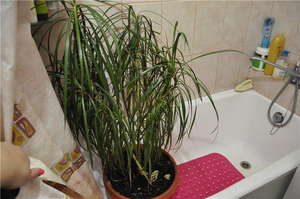 In order for dracaena to reproduce successfully, it is necessary to observe the correct temperature regime and have a certain lighting.
In order for dracaena to reproduce successfully, it is necessary to observe the correct temperature regime and have a certain lighting.
The plant loves medium temperatures. The thermometer should not exceed 32 degrees. A comfortable temperature in winter is considered to be a range of 15-18 degrees. During this period, you need to abandon abundant watering.
If there is poor lighting and very warm content, the plant loses its beautiful appearance. Dracaena in the daytime does not tolerate sunlight. It is better to put it in a slightly dark place. In complete darkness, the plant withers quickly.
For good formation and growth, the plant needs strong lighting. It grows well in the light of fluorescent lamps. A one and a half meter palm tree will grow beautifully in the light of two such devices, with a power of 18 watts. Moreover, the crown of the plant should have maximum uniform illumination.
If you properly care for this plant in your room, then it will delight its owner with a gorgeous look for a very long time.
Dracaena breeding methods
There are many varieties and varieties of dracaena. They differ in the appearance of the plant and the color of the leaves, which are both ordinary green and variegated. Almost all of the indoor dracaena reproduce quite easily at home.
This can be done:
- by the seed method;
- air layering;
- by cuttings.
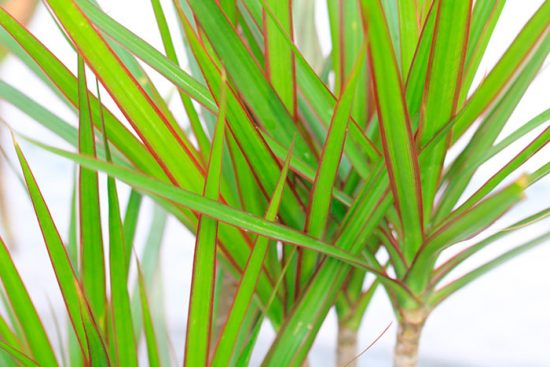 Dracaena is one of the most popular indoor plants.
Dracaena is one of the most popular indoor plants.
But not all of these plant propagation methods are equally simple. For example, it is quite difficult to achieve flowering of dracaena in an apartment, and the seeds, in addition to this, must also ripen.Reproduction by air layers is a rather laborious process that causes some difficulties not only for beginners, but even for experienced flower growers. Therefore, the grafting method is more often used. With this method of reproduction of dracaena, a new plant can be obtained in two ways:
- apical cuttings;
- stem cuttings.
Transplanting cuttings and caring for a young dracaena
When the roots on the cuttings reach a length of 4-5 cm, then they can be planted in pots with special soil for dracaena. If the cuttings were in the water, then it will be clearly visible. When the cuttings are rooted in the sand, then there is no need to rush to transplant - let several well-developed leaves grow on the processes.
Transplant young plants into small pots (about 8 cm in diameter). Lay drainage (expanded clay or broken brick) at the bottom, 2 cm of soil on top. Then you need to put a stalk with roots and sprinkle it with soil again. Compact the soil.
If the stalk is rooted in the sand, then it must be carefully removed, shaken off the excess sand and planted in a pot with soil.
After transplanting cuttings, caring for them is the same as for an adult dracaena. They need bright, but diffused light, direct sunlight should not hit the leaves. In summer, the ambient temperature should be 20-25 degrees, and in winter it should be reduced to 15.
Watering dracaena likes moderate, but regular. In summer, it is usually 2 times a week, and in winter, 1 time a week is enough, but the soil should not dry out
In the room where dracaena grows, the air must be humidified, this is especially important for young plants
Dracaena: plant propagation using apical cuttings
So, your dracaena has become ugly, has ceased to be attractive, do not despair, it can be restored to its previous state, you just have to give it a little attention.
Take a sharp knife and cut off the top of the plant along with the leaves. The cut should be perpendicular to the trunk and be 15-17 cm from the last leaf. Clean the stem from the remnants of leaves and old foliage, everything, the seedling can be considered ready for planting. It remains to dry it a little at room temperature for three hours.
A rooting cut can be made in several ways:
- by placing the stalk in water, to which it is necessary to add charcoal or a preparation stimulating root formation;
- by placing the stalk in a mixture of peat, sand and crushed coal;
- by placing the stalk in a container with vermiculite or perlite, at the request of the grower;
- by placing the stalk in a container with a steamed soil mixture, specially produced for dracaena, palms and other types of exotic plants.
Watering is also done very carefully and dosed. The roots of a plant can rot from a large amount of water and dry out from a lack of it. The florist will have to balance to prevent either one or the other. Water is used only warm, at room temperature, at least + 20 degrees. It is defended for about a day, and only after that the cutting is watered and sprayed. Dracaena is very good at irrigation, using this method you can not only water, but also feed the plant.
Do not throw out the remaining stem with the root, it can also be reanimated and a full-fledged beautiful plant can be grown from it. It is enough to cover the stem with a bag and put it in a warm place, of course, water it periodically. After about 30 days, lateral shoots will begin to wake up on the trunk, which will soon turn into full-fledged branches. The updated dracaena will be able to continue its existence as a multi-stemmed plant.
Propagation by stem cuttings
How to plant a dracaena at home? In some situations, the plant for some reason looks very bad and dies, but there are still parts of the stems that are suitable for growing a new flower.In this case, it is quite appropriate to apply the dracaena propagation technique using stem cuttings. To do this, select that part of the stem that does not contain cracks and superficial damage, and cut the cuttings about five centimeters in size. The cut is best done in the places where the leaves are attached. Each stalk must contain at least two buds. Rooting is carried out in the sand in two ways:
- Vertical - the cuttings are planted vertically, one end is deepened into the sand by three centimeters.
- Horizontal - the cut stems are laid horizontally on the substrate and pressed a little without deepening completely. In this case, two or more new dracaena appear.

With this rooting, the soil, consisting of sand, is always kept moist. The optimum air temperature in the apartment is twenty-five degrees. The roots begin to appear after two months.
Dracaena: breeding at home
Dracaena breeding is thought of at the end of winter. But the optimal time for breeding is March-April. The gradually increasing daylight hours have a beneficial effect on the growth and development of a new plant, stimulating it.

Dracaena
Reproduction of a flower in the fall is allowed. But in this case, it will take longer than usual to expect the appearance of young shoots. The plant may require additional growth stimulants, as well as special lighting. Dracaena most often reproduces:
- air layering;
- stem cuttings;
- seeds;
- apical cuttings.
Different types of dracaena reproduce at home in different ways. So, bordered dracaena (the most common type of ornamental plant) propagates by cuttings and layering, but not by seeds, since flowering does not occur under artificially created conditions. Fragrant dracaena blooms, so the seeds can be collected and used to breed a new flower.
When propagating seedlings or thinking about how to plant dracaena for the first time, in any of the mentioned ways, take into account the possibility:
- rotting of cuttings (if the soil is too wet or the soil mixture is not suitable for a particular plant, then there is a risk of rotting of that part of the cuttings that is stuck in the ground, but has not yet had time to overgrow with roots);
- lack of seedlings (usually the first shoots when growing a flower from seeds appear after 1-2 months, but if the growing conditions do not meet the required ones, then the process can be delayed);
- the absence of lateral shoots in the mother flower (if the grower who cut the stem from the mother plant for its subsequent rooting, forgot to wrap the cut with a plastic bag, then the adult plant will not give young shoots, it may dry out).
The problem with rotting cuttings is solved by simply removing the rotted part and replanting the cuttings in new soil. You can throw away the container with unripe seeds after 5-6 months. If the seedlings did not appear before this time, then the seeds were spoiled or too old. It is not easy to find fresh seeds in the store.
Reproduction of dracaena at home
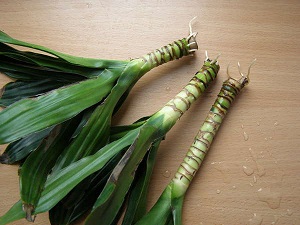 Most often, when the dracaena reaches the level of the ceiling, its appearance becomes no longer so attractive, in this case it is worth thinking about the reproduction of the plant. Best of all, at home, the reproduction of dracaena sandera, bordered and deremskaya, takes place. This procedure should be carried out in March or April, when the growth process is activated. Dracaena propagates by cutting with the top or stem.
Most often, when the dracaena reaches the level of the ceiling, its appearance becomes no longer so attractive, in this case it is worth thinking about the reproduction of the plant. Best of all, at home, the reproduction of dracaena sandera, bordered and deremskaya, takes place. This procedure should be carried out in March or April, when the growth process is activated. Dracaena propagates by cutting with the top or stem.

Dracaena reproduction scheme with an apical cut
Cutting preparation
Carefully cut off the top of the plant, the length of the cutting should be 10-15 cm. The cut can be straight or obliquely. The main thing is not to allow any damage to the cutting, this can lead to further rotting of the plant. The cut must be smooth.
After cutting, you can dry the cutting at room temperature for several hours, or immediately start rooting.Before rooting, it is necessary to clean the base of the cutting from the leaves.
Rooting
Rooting of cuttings occurs in water and various substrates: sand, hydrogel, perlite, soil for cacti and palms. Each substrate has some differences.
When rooting the apical stalk in water, keep it at room temperature. As soon as the water becomes cloudy, it needs to be changed, approximately this procedure is done 1-2 times a week. Water stays fresh longer if you add an activated carbon tablet to it. To speed up the process of emergence of roots, add 2-3 drops of Zircon to a glass of water.
If you decide to root the tip in one of the substrates, before the procedure itself, you should moisten the cutting with water and sprinkle with a powder preparation. (Kornevin, Heteroauxin, Ukorenit, Potassium humate and others). Next, it is recommended to mix the substrate with one of the liquid preparations (Zircon, Epin, Ecogel), after which you can root the cutting.
Without proper care, the cuttings can rot in any substrate, as well as in water. Most often, rotting occurs in soil due to the presence of microorganisms in them, which can destroy the tissues of the cutting.
Carefully ensure that the substrate is not overmoistened, this factor leads to rapid decay. From overdrying, the tissues of the cuttings and the resulting roots dry out.
It is best to root the tip in a substrate at an air temperature of 20-22 ° C. It is recommended to create the conditions of a mini-greenhouse, that is, cover with plastic, a transparent bag or glass. Be sure to spray the leaves with water at room temperature at least three times a day and additionally with a solution of fertilizer for palm trees once a week. Until the plant has no roots, nutrition occurs through the leaves.
Propagation of dracaena stem cuttings
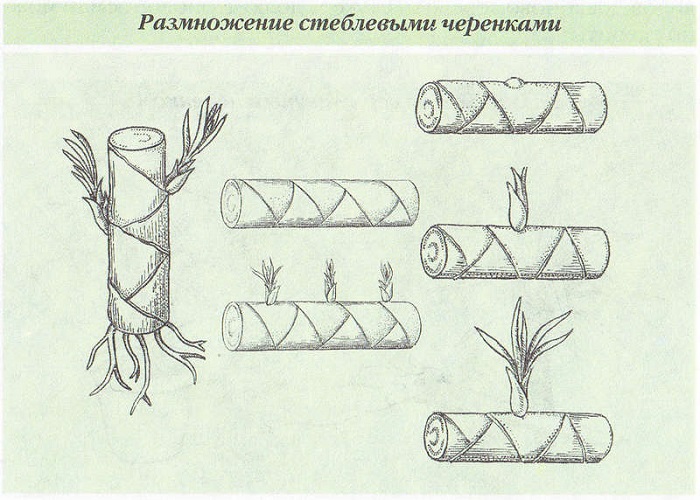
Dracaena propagation scheme with stem cuttings
Basically, this type of reproduction is used if the top of the plant has wilted. To do this, you need a healthy plant stem, elastic to the touch and at least 2 cm in diameter, divided into pieces 5–20 cm long. Slices must be done very carefully along the leaf scars (the places where the leaves are attached to the stem). The dividing tool must be sharp.
Rooting itself is done in the substrates listed above. Propagation by stem cuttings is of two types:
- Vertical. The lower part of the dracaena stalk is immersed in the substrate to a depth of about 2-3 cm. When rooting in the soil, it is imperative to sprinkle it on top with a layer of sand 5-6 cm thick. roots first in the sand, and then in the soil;
- Horizontal. In this type, the cuttings should be laid on the surface of a damp substrate and lightly pressed into it. At the same time, observe soil and air temperatures of 20-24 ° C. It is recommended to rooting in a greenhouse.
The difference between root cuttings and stem rootings is that in the first case, only roots are formed at the apex, and in the second case, including shoots, germinate. In the horizontal rooting method, the stem breaks down over time due to the fact that all its nutrients are wasted in the formation of shoots.
After the shoots start feeding on their own roots, the cuttings can be planted in pots.
How to take a scion from a dracaena
It is convenient for flower growers to propagate dracaena by cuttings. If you want a new houseplant, there are other ways you can choose:
 Reproduction by apical cuttings photo
Reproduction by apical cuttings photo
Apical cuttings. Before the procedure, choose a quality and convenient instrument. Do not forget about pre-antiseptic treatment. Cut off the top of the trunk with all the bifurcations and put it in the water. Do not be afraid for the stalk of the maternal donor - new shoots will certainly appear at the cut site with proper care.
Stem cuttings. Usually this method is opened for the owners completely by accident.
After the stem or its branching shoots inadvertently break, their cuttings can be used as the next potting plants.
Air layering. This method is best done during the warmer months.
This is especially true at the time of active growth of lateral shoots. First, a site is selected, and after that an incision is made. Further, a polyethylene air cushion is organized on the trunk at the cut of the cutting, into which fertilized soil is poured. It is necessary to wait for the moment when roots appear on the cutting and start transplanting.
Seeds. If you can't take a scion, you can simply buy dracaena seeds at a flower shop. Plant them in a specially designed and prepared pot.
The decision to breed dracaena must be deliberate. To take a scion, you need to approach this issue very responsibly.
At the time of cuttings, the plant should be given increased attention and careful care. Dracaena will recover for a very long time after apical cuttings.
Remember that life expectancy and size directly depend on your work. During this period, do not forget about the abundant watering, which the representative of the Asparagus family loves so much.
2 How to propagate dracaena at home
Every year, at home, dracaena shoots grow by 10-15 cm.Over time, this leads to their excessive stretching and loss of the plant's attractiveness. The owner of such a plant is forced to take measures to limit the growth of shoots in height. One of the options for such restrictive measures is plant rejuvenation. It is convenient to combine it with reproduction. As a result, you will get 2 copies of plants: a young one, just beginning its development, and a renewed maternal one.
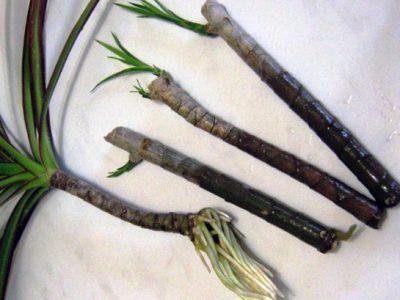
Dracaena can be rejuvenated and at the same time propagated vegetatively using apical or stem cuttings. Cutting is best done in spring, during the active growing season of the plant.
When dracaena needs a transplant
How to plant a dracaena flower, if you really want to propagate it, is described in detail above. But there are times when you just need to rejuvenate the plant and encourage it to grow further. Knowing how to plant the dracaena correctly and when to do it, you can grow a wonderful healthy shrub.

The optimal time for transplanting will be February – March. At this time, the flower wakes up after winter, and its vital processes awaken. At this time, the transplant will not be very stressful for the flower.
Several cases when it is recommended to plant a dracaena:
- The flower needs a pot change. The roots of the plant have grown greatly, and the shoots are exposed from the ground - it's time to choose a larger pot for the dracaena and renew the soil. So the plant will have more free space, which means that it will grow.
- Transplanting a purchased plant. As a rule, indoor flowers are sold in plastic containers that are not intended for long-term flower cultivation. Also, the soil in the pot may not be of the highest quality; it is better to replace it yourself.
- Dracaena will have to be planted if the flower is flooded with water and the roots begin to rot.
Related video gallery
{{svg_embed_icon}}
Dracaena pruning and what came of it
{{svg_embed_icon}}
DRACENA PRIMING AND REPRODUCTION
{{svg_embed_icon}}
Dracaena pruning
{{svg_embed_icon}}
Dracaena - How to form a crown
{{svg_embed_icon}}
Dracaena after pruning
Many growers are wondering how to prune dracaena to obtain side shoots. This is necessary in order to achieve a lush branching crown from this unpretentious domestic palm tree. In order not to worry about where to run and where to read the necessary information, it is worth familiarizing yourself with practical tips on how to prune a palm tree and get side branches on it.
Many growers are wondering how to cut dracaena to get side shoots.
Since such a flower grows long enough, an elongated single trunk with sparse leaves does not look very beautiful. But not everyone knows whether it is possible to cut the dragon tree and how best to do it. There is a possibility that the long stem will sooner or later break under its own weight. To avoid this, as well as to increase the decorativeness of the plant, it must be pruned. In order to obtain an attractive crown, this procedure should be carried out competently and in a timely manner.
As a rule, already formed dracaena with several rosettes of leaves on one trunk are sold in flower shops. But if this plant is obtained by propagation by cuttings, then it looks like one shoot with a not very dense crown at the top. In this case, it is necessary to stimulate additional branching, which increases the decorative effect of the flower. At your own request, you can either update the dracaena or form a lush crown on an old plant. This indoor flower is quite unpretentious. He responds well to such procedures. It is simple to take care of it: keep it on a sunny window, water it on time, protect it from drafts.
Young dracaena is a rosette of long feathery leaves on an erect stem. In its shape, this plant resembles a palm tree, although it is not. The higher the trunk of the dracaena, the more woody it becomes. The lower leaves dry up, they have to be cut off. The bald stem greatly reduces the decorative qualities of the plant. To get a branched trunk and keep the attractive appearance of the dracaena, it must be trimmed in time.
You can wait until the top of the plant starts to rest against the ceiling. But it is advisable to carry out the formation of the crown in a timely manner, without waiting for the complete baldness of the stem. Proper care of dracaena at home involves not only creating optimal moisture and lighting conditions for the plant, but also cutting off the lignified parts of the trunk. Otherwise, the life of the flower is reduced, and its appearance also deteriorates. An interesting visual effect is provided by shortening several shoots in one pot at different heights.
Don't worry if the stem of the plant breaks at the wrong time.
It should be carefully removed with a sharp knife below the fracture site and processed according to the instructions below. The broken off top can be used for reproduction, for which the stem must be cut into pieces of 10-15 cm (with the obligatory lateral bud), thus obtaining planting material
Cuttings can be planted and rooted in a special substrate. This process is quite easy, so in a short time you can get several young plants.
Ground germination - we prepare materials and create a mini-greenhouse
Prepare a small container or plastic cup. Lay a drainage layer of small pebbles or expanded clay on the bottom. This will help keep the soil breathable and moderately moist. To make the substrate lightweight, place sand, perlite, hydrogel or soil in a container. To make the dracaena cuttings root better, add the required amount of rooting agent to the nutrient substrate, and treat the cut itself with charcoal. Plant it in the ground, water it well, and then keep an eye on maintaining moisture.
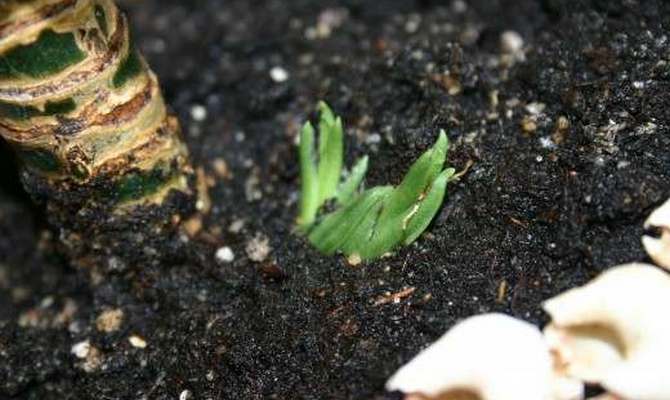
Dracaena soil germination
In order for the roots to form as quickly as possible, we create greenhouse conditions for the shoot. We put a glass jar on top or wrap the container with cellophane. At the same time, do not forget to spray the leaves 3-5 times a week and free the cuttings from the greenhouse for 15-20 minutes a day. It is undesirable to overmoisten the substrate so as not to provoke the formation of fungal microorganisms. The amount of water can be easily adjusted. Take moist earth and try to sculpt lumps out of it.In case of waterlogging, the earth will stick to your hands and smear. When using a hydrogel, there should be no free space, fill the voids as needed.
Conclusion
- Do not rush to get rid of the southerner, after resuscitation she will quickly regain her strength and will grow with renewed vigor, delighting you and your loved ones with the southern beauty of its unusual shape and a bright green hat - a palm tree.
- Dracaena is a plant of official premises, offices, she loves more space, light and air. Accustomed to growing in the lands of eternal summer, warmth and sun, she does not feel very comfortable at home.
- However, if you provide her with full care and create conditions close to natural, the dracaena will thank you with amazingly beautiful and unusual foliage and become a real gem in your home collection of flowers.

